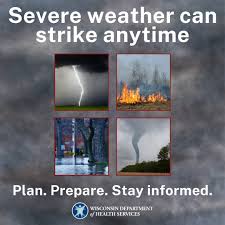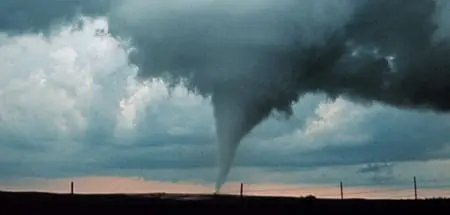Tornado Terminology
For your own safety, it’s important to know the terms you might hear during tornado season. This could mean the difference between possible or immediate danger, and the more time you have to prepare, the better.
- Tornado Watch: Tornadoes are possible. Watch the sky and stay tuned to a NOAA Weather Radio, commercial radio, or television for information. Watch for alerts on your smartphone and check social media for information from trusted sources.
- Tornado Warning: A tornado has been spotted or indicated by weather radar. Take shelter immediately. A warning can cover parts of counties or several counties in the path of danger.

What to Watch Out For:
- Heavy winds
- Swirling debris on the ground, or debris rising up in the air
- A roaring noise
- A dark sky
- Large hail, often without rain
Preparing for a Tornado
Now that you know what words to watch out for, let’s get into ways you can prepare:
- Stay informed: Check the forecast, watch the local news, or tune into the radio. Radios are particularly helpful in the event you lose power.
- Make sure you have a way to receive alerts: The more (reliable) methods, the better. Download a local news app and watch local social media accounts. Make sure your phone is set to receive notifications.
- Know where to go for shelter: Choose a basement, storm cellar, or interior room if possible and cover your head with your arms or a heavy blanket. Avoid rooms with windows. It’s important to identify this location before the emergency so you know where to go.
- Practice makes perfect: Practice walking through the steps of what you would do in a tornado. You can practice with your friends, family, roommates, or coworkers.
If a Tornado Strikes
- Listen to alerts: Have multiple means of receiving alerts and staying updated on tornado information.
- Take shelter: If you want to see what a tornado looks like, google it later. During a tornado watch or warning is the time to take immediate action and seek shelter.
- Drive safely: If you’re outside in a storm, go to the nearest sturdy shelter. Drive at right angles away from the tornado. Never drive towards a tornado or try to outrun it.
- Wait till the storm passes: Wait until you’re sure the storm has passed to leave shelter.
Making a Kit
Having something quick to grab and go in an emergency can better prepare you and give you peace of mind. We’ve put together a list of a few things to have with you just in case. More information can be found here.
- Water (a three-day supply is recommended)
- Non-perishable food (also a three-day supply)
- Cell phone and charger
- Flashlight and batteries
- First aid kit
- Dust mask
- Survival blanket (also known as a space blanket)
- Change of clothes
What Happens Next
In the event a tornado has happened in your location, here are some things to be aware of:
- Cell service may be out due to downed lines or power outages (here’s where the radios come in handy again)
- Watch out for exposed electrical wires, smells of gas from potential leaks, or visible sparks. If possible, shut off utilities if this is observed, or damage is suspected and report these things to your utility provider immediately.
- Be on the lookout for fallen power lines in your area.
- Driving may be dangerous due to debris, the aforementioned downed power lines, or fallen trees.

While we can’t control when or where a tornado will strike, we can take steps to be prepared.
Authored by: Mclayne Vaughn
Originally published April 18, 2025 by UW-Madison Police Department https://uwpd.wisc.edu/tornado-season/



